W.G. Sebald, 57; Author Challenged Norms
W.G. Sebald, a writer who challenged the traditional forms of fiction and nonfiction in a quartet of books that gained widespread critical acclaim over the last decade, died Friday. He was 57.
Sebald was killed in an automobile accident near his home in East Anglia, England, according to a representative of Random House, his American publisher. He had recently completed a U.S. tour in support of his latest book, “Austerlitz.”
“It’s an unbelievable loss for literature,” the writer and critic Susan Sontag, an early champion of his work, said late Friday.
All four of his books explored the lives of people radically changed by World War II. The four--”The Emigrant,” “Vertigo,” “Rings of Saturn” and “Austerlitz”--managed to be ruminative and provocative, yet filled with images and metaphors that lent an eerie beauty to the stories.
“His densely weird books, in which the narrator seems to wander for days through East Anglia or Antwerp, through the train stations and libraries of Europe, through its civic underbelly, have drawn superlatives from such strange bedfellows as Sontag and Mark Levine, writing for Men’s Journal,” wrote Susan Salter Reynolds in The Times.
“The people he takes seriously have been emotionally deadened, almost to the point of paralysis, by all that has been denied or simply forgotten by those determined never to look backward,” UC Berkeley professor Michael Andre Bernstein wrote in The Times earlier this year.
In “Austerlitz,” Sebald tells the story of a boy, raised by Christians in Wales, who discovers that he was actually born a Jew in pre-World War II Prague.
In reviewing the book, Bernstein praised Sebald’s “distinctive, instantly recognizable voice.”
“It is Sebald’s elegiac tone--the fastidious vocabulary, melancholy prose rhythms and seductive emotional reticence--that envelops one from the first sentence . . . “ Bernstein said.
Reynolds, a Times writer who had an extensive interview with Sebald during his recent U.S. tour, said he “writes the way the mind works, moving from observation to memory and back again, jumping or flowing, but moving all the time.”
In each of his books, Sebald employed the use of a narrator to help the key characters reveal the contours of their lives. He also added grainy black and white photographs without captions to give an unsettling feeling of documentary to the work.
Reynolds called the combination of photographs and text “heartbreakingly evocative, as they reached down into the collective image bank that all readers of his work shared.”
Winifred Georg Sebald was born in Bavaria in May 1944, the son of a tinsmith who served in the German Army during World War II, eventually rising to the rank of lieutenant colonel. Sebald himself was the first person in his family to advance beyond primary school. He attended Freiburg University in Switzerland and later Manchester University in England. Since 1970, he has taught literature at the University of East Anglia, with an occasional seminar on German film.
Sebald’s writing career began in the 1960s, when he authored a series of short pieces for a local newspaper to make some extra money. In doing so, he found a calling.
“I found a patch of my own,” Sebald told Reynolds. “It was a kind of therapy, self-therapy. I never thought it would take over, but you write one thing, and then you feel compelled to write another. It’s a kind of compulsive disorder.”
” Writing is quite painful,” he added. “There’s the odd chapter I can do in my sleep, but for the most part, I grind away with dogged persistence.”
“The Emigrants,” the first of Sebald’s books to be translated to English from German, is an autobiographical tale in which the narrator traverses four loosely related stories that occur in various times in European history.
Richard Eder, writing in the Los Angeles Times Book Review, said that “some of the images in Sebald’s brilliant and somber book work inexplicably.”
“The Rings of Saturn” came next. Called more linear in its narrative, the story uses a journey through Suffolk, England, as the central theme in a work that features dreams, observations and memories on a variety of topics.
Eder, again writing in The Times, said that “with all the gracefulness of its writing, its air of simply overserving the oddities of change and its literary digressions, [‘Rings’] is a lament.”
Reviewing the four narratives that make up “Vertigo,” Sontag wrote, “Where has one heard in English a voice of such confidence and precision, so direct in its expression of feeling, yet so respectfully devoted to recording ‘the real’? D.H. Lawrence may come to mind, and the [V.S.] Naipaul of ‘The Enigma of Arrival.’ But they have little of the passionate bleakness of Sebald’s voice.”
Of his overall work, UC professor Bernstein wrote: “History is a nightmare into which Sebald’s characters and his books as a whole are trying to awaken.”
Sebald is survived by his wife and a daughter.
Funeral arrangements are pending.
More to Read
Sign up for our Book Club newsletter
Get the latest news, events and more from the Los Angeles Times Book Club, and help us get L.A. reading and talking.
You may occasionally receive promotional content from the Los Angeles Times.






